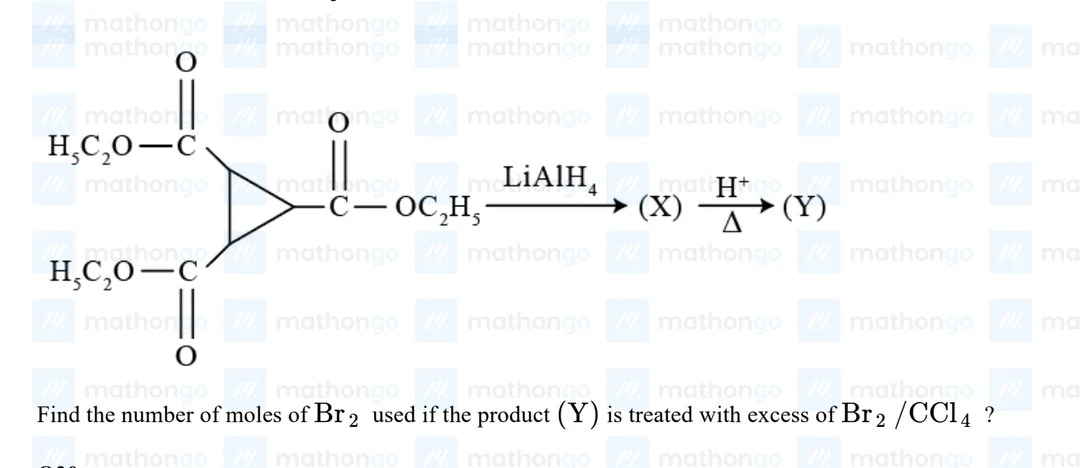Question
Question: Find the number of moles of $Br_2$ used if the product (Y) is treated with excess of $Br_2/CCl_4$?...
Find the number of moles of Br2 used if the product (Y) is treated with excess of Br2/CCl4?

3
Solution
The starting material is cyclopropane-1,2,3-tricarboxylate. Its structure is a cyclopropane ring with three ethoxycarbonyl groups (−COOC2H5) attached to each carbon of the ring.
Reaction with LiAlH4 reduces the ester groups to primary alcohols. Thus, product (X) is cyclopropane-1,2,3-trimethanol.
Product (X) is treated with H+/Δ. This involves acidic conditions and heating, which can cause dehydration of alcohols and ring opening of the strained cyclopropane ring. A likely product under these conditions is benzene, which is a stable aromatic compound and can be formed from a C6 precursor with sufficient unsaturation. Cyclopropane-1,2,3-trimethanol has the formula C6H12O3. Dehydration to form benzene (C6H6) involves the loss of 12−6=6 hydrogen atoms, which corresponds to the loss of 3 molecules of water (3×H2O). The degree of unsaturation of C6H12O3 is 1 (due to the cyclopropane ring). The degree of unsaturation of C6H6 is 4 (benzene ring). This is consistent with the formation of a benzene ring, which requires ring opening and rearrangement. While the exact mechanism might be complex, the formation of benzene from a C6 precursor with appropriate functional groups under strong acidic conditions and heating is a plausible outcome, especially when considering the stability of the aromatic product.
So, product (Y) is benzene.
Benzene is then treated with excess Br2/CCl4. The reaction of benzene with Br2 in the absence of a catalyst is slow and requires UV light for radical substitution.
Let's assume that the question is asking about the reaction of product (Y) with excess Br2/CCl4, and the intended reaction is addition to any double bonds present. If (Y) is benzene, it has 3 formal double bonds. Addition of Br2 to a double bond is a 1:1 reaction. So, if addition occurs to all three double bonds, it would consume 3 moles of Br2.
The product would be hexabromocyclohexane. This reaction can occur under UV light or high pressure. Given the context of JEE/NEET level questions, and the common reactions of benzene, it is possible that the question intends to test the addition reaction of benzene with excess bromine.
Let's assume that product (Y) is benzene and the reaction with excess Br2/CCl4 refers to the addition reaction. In this case, 3 moles of Br2 are added to the three double bonds of benzene to form hexabromocyclohexane.
Therefore, the number of moles of Br2 used is 3.
